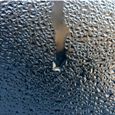Condensation
KNB0002
Most of us have been blessed with the experience of pouring an ice-cold beer into a tall glass, on a hot summer day. While lifting the refreshing drink to our dry lips, we have enjoyed the feel of the cool glass and the sight of the moisture and droplets forming on the outside of the glass.

17/05/2006 11:41:36
The moisture of course, is condensation, and while it is wonderful on a glass containing a cold drink, it is detrimental to the performance of a coating system if it forms on a substrate / surface immediately before or during application / drying.
The temperature at which condensation starts to form on a surface is called the Dew Point. It is dependent on the relationship between the Temperature and the Humidity of the air. Since sudden changes in air temperature or humidity can occur, and substrate / surface temperatures are slower to react, we recommend a substrate / surface temperature 4ºC above the dew point at the start of the work to compensate for fluctuations.
Substrate / surface temperatures can be measured with special thermometers or with a normal thermometer puttied firmly against the surface. Humidity can be determined by a Whirling or Sling Hygrometer, usually requiring determination of wet and dry bulb temperatures.
Dew point occurs at different combinations of humidity and air temperatures. For instance, if the air temperature is 14ºC and the relative humidity is 55% the Dew Point is nearly 5ºC. If the surface temperature of the substrate / surface is to be 4ºC above the Dew Point, the minimum allowable surface temperature is 5ºC + 4ºC = 9ºC.
If the necessary equipment is not at hand to measure temperature and humidity, the Dew Point requirement can in practice be presumed to be satisfied if a thin film of water applied to the cleaned surface with a wet cloth dries within 15 minutes. The period during which a freshly applied paint film is sensitive to condensation depends entirely on the type of paint system to be used. The physical film formers, (e.g. Vinyl, Chlorinated Rubber) become resistant as soon as the solvents have evaporated.
Give the dew point a thought next time you pour yourself an ice-cold beer!
Definitions
Condensation: The droplets or water film formed on a surface when the temperature is at or below the dew point.Dew Point: The temperature at or below which water vapour in the air will condense.
Humidity: The percentage relation between (1) the actual amount of water vapour in a given volume of air at a given temperature, and (2) the maximum amount of water vapour that would be present if the air were saturated with water vapour at that temperature.